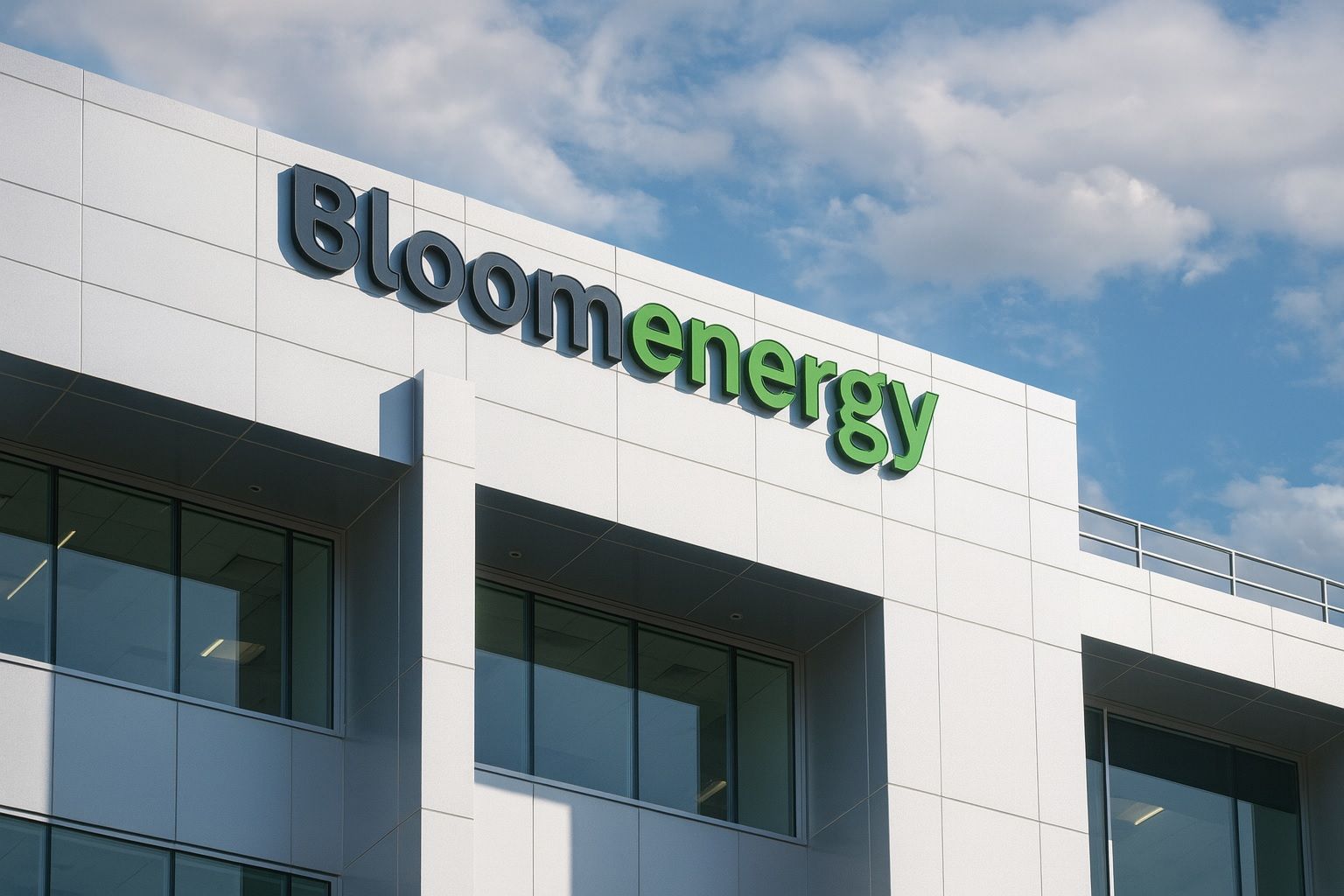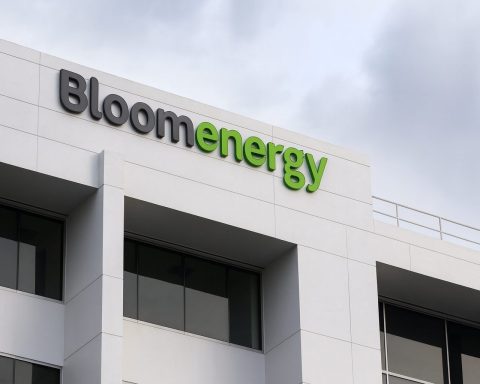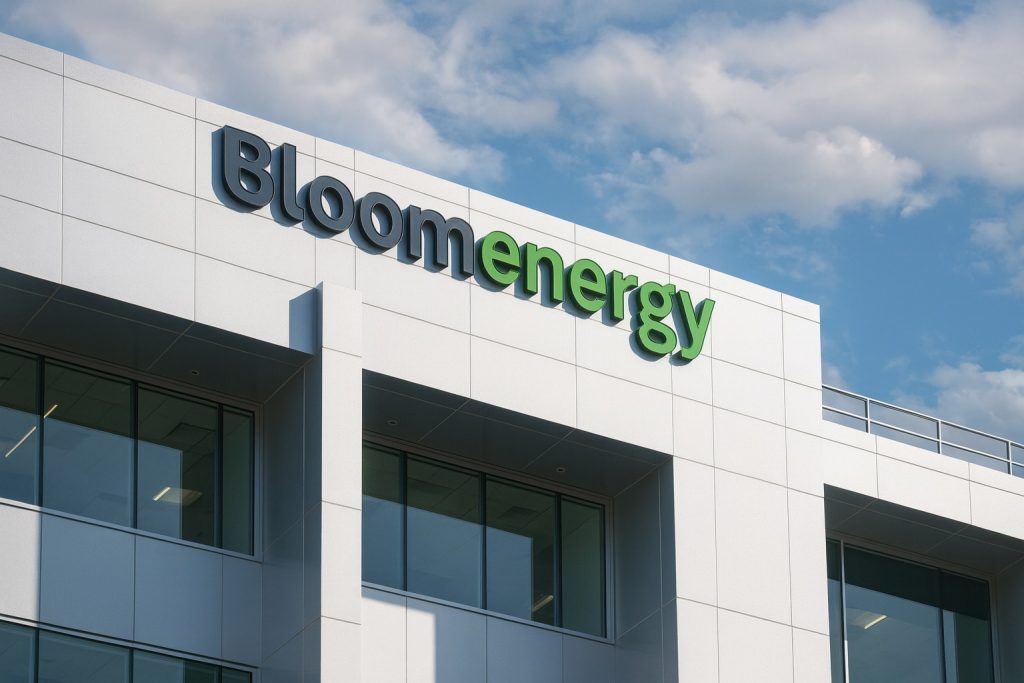- Brookfield Deal: On Oct 13, 2025 Bloom Energy (NYSE: BE) and Brookfield Asset Management announced a $5 billion partnership to power AI data centers with Bloom’s fuel cell technology [1] [2]. Brookfield will invest up to $5 billion to deploy Bloom’s solid oxide fuel cells, making Bloom the preferred onsite power provider for Brookfield’s global “AI factories” [3] [4].
- Clean, Onsite Power: Bloom’s fuel cells generate clean, scalable power on-site from fuels like natural gas, hydrogen or biogas. They can be deployed rapidly (often in ~90 days) and capture waste heat, boosting efficiency from ~54% to upwards of 85–90% [5] [6]. This makes them well-suited to the “spiky” loads of AI computing, where power demand can fluctuate 50–100 MW in seconds [7] [8].
- AI Power Crunch: Industry experts warn that AI workloads are driving data-center power needs to skyrocket. U.S. AI data centers could demand over 100 GW by 2035 [9] [10]. For context, data centers already use ~1.4% of global electricity, and analysts project demand roughly doubling by 2030 [11]. Bloom’s partnership with Brookfield directly targets this impending power shortfall in AI infrastructure.
- Bloom’s Track Record: Prior to this deal, Bloom had deployed hundreds of megawatts of fuel-cell power at major data centers. Its systems already supply “over 400 MW” of power generation to data centers worldwide [12] (including deployments with Oracle, Equinix, American Electric Power and others [13]). This deal – Brookfield’s first AI-infra investment – will scale that effort globally, including new sites (a European “AI factory” is planned by year-end [14] [15]).
- Stock Surge: Bloom Energy shares soared on the news. In early Monday trading (Oct 13), Bloom jumped ~26–27%, trading around $110 per share in the pre-market [16] [17] (versus ~$86.87 close on Oct 10 [18]). Other outlets report intraday highs near 30–35% gains [19] [20]. By market open, Bloom was among the day’s top gainers on the NYSE.
- Expert Opinions: Bloom’s CEO KR Sridhar and Brookfield’s AI head Sikander Rashid highlighted how the deal redefines data center power: “AI infrastructure must be built like a factory — with purpose, speed, and scale,” said Sridhar [21] [22]. Rashid noted that behind-the-meter fuel-cell power is “essential to closing the grid gap for AI factories” and gives unique flexibility in today’s constrained markets [23]. Outside experts echo this view: for example, TS2 reports that Microsoft has been testing fuel-cell backups (a 3 MW hydrogen generator) to replace diesel on-site generators, underscoring industry interest in zero-emission data center power [24].
$5B Brookfield Partnership Details
Brookfield Asset Management (NYSE: BAM) – a $1+ trillion alternative asset manager – unveiled this strategic AI-infrastructure investment on Oct 13, 2025. According to Brookfield and Bloom’s joint announcement (via BusinessWire and Nasdaq): Brookfield will invest up to $5 billion to “deploy Bloom’s advanced fuel cell technology” at AI data centers [25] [26]. The partnership marks Brookfield’s first move in its dedicated “AI Infrastructure” fund, which already includes investments in data centers and renewable energy globally. Brookfield’s Sikander Rashid explained that Bloom’s fuel cells give Brookfield “the unique capability to design and construct modern AI factories with a holistic and innovative approach to power needs” [27].
From Bloom’s side, Founder/CEO KR Sridhar emphasized that AI data centers are unlike any other industrial facility. “AI factories demand massive power, rapid deployment and real-time load responsiveness that legacy grids cannot support,” he said [28]. Bloom’s modular fuel cells can be installed in a matter of weeks (since they arrive pre-assembled on skids [29]), enabling data center operators to add capacity without waiting months (or years) for utility grid upgrades. Sridhar added that this partnership is about “reimagining the data center of the future” with compute, infrastructure and power designed in sync from day one [30].
The press release notes that Bloom and Brookfield are already collaborating on specific projects, including multiple AI data center sites globally. One such site in Europe will be announced by year-end [31] [32]. In short, Brookfield provides the capital and infrastructure expertise, and Bloom provides the clean, on-site power. Together, they aim to build “AI factories” – data centers built like manufacturing plants – that can scale power as demand grows [33] [34].
Fuel Cells and the AI Power Crunch
The context for this deal is a looming power crunch in AI data centers. All the major cloud and AI players (Google, Microsoft, Amazon, OpenAI, etc.) are rapidly expanding their server farms to train and run generative AI. Analysts warn this will strain electric grids. For example, S&P Global projects U.S. data-center power demand rising ~12% per year through 2030, meaning major expansion of generation capacity [35]. A U.S. Department of Energy report cited by BloombergNEF notes data centers now consume ~1.4% of global electricity (2024) – and that share is climbing [36]. On balance, industry watchers say sustainable, onsite power solutions will be essential.
Bloom’s solid oxide fuel cells (SOFCs) are tailored for this environment. Unlike diesel generators, they can run continuously with minimal emissions (and virtually no NOₓ or SOₓ pollutants) [37]. Crucially, they handle rapid load swings gracefully. Bloom’s engineers note a single AI server rack can see its power jump from 15 kW to 30 kW in seconds. Across a whole data center, this means spikes of tens of megawatts. According to Bloom’s data, its fuel cells and accompanying supercapacitors can respond instantly to such spikes, delivering >99.9% uptime and hundreds of thousands of charge cycles [38]. Batteries alone would wear out quickly under these conditions, but fuel cells simply throttle output to match compute needs, thanks to their electrochemical design.
An added advantage is efficiency: Bloom’s SOFCs run hot (operating temperatures ~750–850°C), so waste heat can be captured for cooling. By coupling fuel cells to absorption chillers, Bloomberg and TS2 report that a data center can boost overall energy efficiency from ~54% to roughly 85–90% [39]. That heat-recovery approach also lowers power usage effectiveness (PUE) – the lower the PUE, the greener the data center. Microsoft, for example, has experimented with 3 MW fuel-cell generators specifically to replace diesel gensets [40]. The trend is clear: major tech firms are already piloting hydrogen/battery hybrids and fuel-cell backup systems to cut carbon and ensure reliability [41].
In sum, Bloom’s fuel cells align with two crucial trends: greening data centers and accelerating deployment. With legacy grid connections often delayed by permitting or capacity constraints, data center builders increasingly look for modular, off-grid solutions. In a Bloomberg-TS2 analysis, experts noted that companies like Amazon and Equinix are testing containerized battery and fuel-cell microgrids to bypass grid waiting times [42]. Bloom’s backers argue that by investing in such behind-the-meter power, the Brookfield deal will help close the gap between surging AI demand and limited grid availability [43].
Market Reaction and Stock Forecast
Investors reacted enthusiastically. On Oct 13, BE’s pre-market price spiked about 25–30% above the prior close. For instance, Reuters reported Bloom stock trading up 25% at $108.84 pre-market [44]. Investing.com and StockTwits reported similar surges (roughly +20% to +35%) on Monday [45] [46]. The Investing.com piece highlighted that the stock “soared” after the announcement [47]. According to intraday data, Bloom closed Oct 10 at $86.87 [48] and opened Oct 13 over $110 [49] – a jump of roughly 27%. By midday trading, BE was still significantly higher than the prior week’s levels. (For comparison, just a few days earlier on Sept 30 BE had closed around $84 [50].)
This rally also altered valuations. Before the deal, analysts had widely divergent views on Bloom. One Nasdaq report noted that as of Sept 30 the average one-year price target was only $51.25, implying a 41% drop from the then-price [51]. Top street targets ranged up to $110, but some (like BMO) were as low as $18 [52]. The sharp jump after the Brookfield news suggests analysts will revise forecasts upward. Indeed, on Oct 7 Evercore ISI had just started coverage with an outperform rating and $100 target [53] – right around the new market price.
From a fundamentals angle, Bloom had been showing accelerating growth. In 2Q25 revenue reached $401.2M, up 19.5% year-over-year [54]. Product sales alone jumped 31%. The company guided FY2025 revenue to $1.65–$1.85 billion [55]. Consensus forecasts (pre-deal) called for ~20% annual sales growth into 2026 (to ~$2 billion) [56], along with expanding profitability (EPS around $0.50 in 2025 and $0.75 in 2026 [57]). The Brookfield deal provides fresh growth visibility: analysts now see a significant new revenue stream (fuel-cell installations and service contracts for Brookfield’s AI projects). At the same time, Bloom may incur additional costs to ramp manufacturing. Industry watchers will be watching whether the deal translates into concrete orders in 2026.
Some institutional investors are very bullish. A Zacks “Bull of the Day” commentator argued before this deal that Bloom’s growth was “just beginning”, citing an explosive backlog of demand (Oracle’s multi-billion cloud buildout, OpenAI/Meta initiatives, etc.) [58] [59]. That analysis noted analysts were “behind the curve” and expected Bloom to eventually capture orders in the 900+ MW range (e.g. a Wyoming 900-MW project was recently reported) [60]. Post-deal, if Brookfield actually plows the full $5B into Bloom products (roughly 2.5 GW of fuel cells at current pricing), Bloom’s order backlog and sales could jump significantly. Even prior to this deal, Bloom’s backers argued that GenAI and new nuclear build delays guarantee strong demand for modular fuel cells. As one expert quipped, Bloom’s rapid-deployment power boxes could allow it to grow as fast as companies like Generac did during the home-generator boom [61].
Expert Commentary & Outlook
Industry and academic experts emphasize that AI workloads have made data center power “the elephant in the room”. As one climate expert noted (at a DC summit), AI centers are “competing directly with humans for … energy” [62]. Fuel cells and other alternatives are already key topics in these discussions. For example, TS2 reports that leading tech firms are part of a “Green Data Center” trend – Germany now mandates 100% renewables for data centers by 2027, and companies are trialing hydrogen, batteries and even recovered heat to meet AI’s needs [63] [64]. In this context, Bloom and Brookfield’s move is seen as a major new entry: it essentially commits billions to fuel-cell powered AI data centers, potentially accelerating broader adoption of the technology.
Bloom’s own executives frame this as a generational shift. “AI factories [will be] built with power, infrastructure, and compute designed in sync from day one,” said KR Sridhar [65]. This echoes analyst chatter that data centers of tomorrow will be designed holistically, not as an afterthought to the grid. Brookfield’s Rashid noted that as a top AI infrastructure investor (with over $100B already in digital assets), adding on-site fuel cells “adds a powerful new tool to our global growth strategy, especially in a grid-constrained environment” [66].
From a stock perspective, some analysts will likely increase their price targets. Evercore’s $100 target (issued right before the news) may be easily surpassed. If even a fraction of Brookfield’s $5B is spent in the next year or two, some models could predict Bloom’s revenues jumping 30–50% in 2026 versus prior base. On the other hand, commentators caution that Bloom’s profit margins and execution will need to prove out with these large deals. Historically, Bloom has operated at a net loss (due to R&D and manufacturing ramp costs), though it did briefly hit a GAAP profit in Q2 2025 [67]. How quickly Brookfield-funded projects translate to net income (versus expenses) will be key for the stock’s sustained performance.
Forecasts: At the moment (Oct 13, 2025), BE trades around $110 after the jump. Analysts’ consensus (pre-deal) was around $80–90 for this timeframe, so the market is now above most targets. If Bloom can confirm any multi-hundred megawatt orders this quarter, many would view the stock as still undervalued. A conservative investor might wait for the dust to settle (project announcements and a revised guidance), while a more aggressive one might see the rally as justifiable given Bloom’s strategic position. Notably, Bloom’s stock volatility is high – it fell from $77 to $61 in late Sept, then shot up to $110 in early Oct (a 44% drawdown followed by 42% rally in two weeks). Some profit-taking could occur, but tech and energy investors may pinch-hit this dip as a generational opportunity.
Bottom Line: The Bloom Energy–Brookfield partnership is a landmark for both companies and for AI infrastructure. It signals that “AI factories” will require rethinking of power supply, prioritizing fast, on-site, low-carbon solutions. For Bloom, the deal validates its fuel cell strategy and deepens its ties with the hyperscale data center market. For Brookfield, it cements a role in the AI supply chain beyond just real estate and grid power. Publicly, experts are bullish on the narrative – they quote Bloom and Brookfield execs, energy analysts, and even academic studies all underscoring the urgency of this power demand. As one TS2 summary put it: companies are turning to every available clean-tech (batteries, hydrogen, fuel cells, demand response) to power the AI boom [68]. If Bloom can execute, its stock and fundamentals may reflect a leadership position in this $5 billion-plus contest. Investors will watch closely for order flow and partnerships in the coming months to validate this bold collaboration.
Sources: Official press releases and financial news outlets were used for details and quotes [69] [70] [71]. Industry analyses and TS2.tech reports provide context on data center trends and fuel cell applications [72] [73]. Stock price data is from market sources [74] [75]. All statements and statistics are attributed to cited sources.
References
1. www.reuters.com, 2. www.businesswire.com, 3. www.businesswire.com, 4. www.nasdaq.com, 5. www.bloomenergy.com, 6. www.businesswire.com, 7. www.bloomenergy.com, 8. www.bloomenergy.com, 9. www.businesswire.com, 10. www.investing.com, 11. ts2.tech, 12. www.bloomenergy.com, 13. www.investing.com, 14. www.businesswire.com, 15. www.nasdaq.com, 16. www.reuters.com, 17. www.investing.com, 18. www.investing.com, 19. stocktwits.com, 20. www.reuters.com, 21. www.businesswire.com, 22. www.investing.com, 23. www.businesswire.com, 24. ts2.tech, 25. www.businesswire.com, 26. www.nasdaq.com, 27. www.businesswire.com, 28. www.businesswire.com, 29. www.bloomenergy.com, 30. www.businesswire.com, 31. www.businesswire.com, 32. www.nasdaq.com, 33. www.businesswire.com, 34. www.nasdaq.com, 35. ts2.tech, 36. ts2.tech, 37. www.bloomenergy.com, 38. www.bloomenergy.com, 39. www.bloomenergy.com, 40. ts2.tech, 41. ts2.tech, 42. ts2.tech, 43. www.businesswire.com, 44. www.reuters.com, 45. www.investing.com, 46. stocktwits.com, 47. www.investing.com, 48. www.investing.com, 49. www.investing.com, 50. www.investing.com, 51. www.nasdaq.com, 52. stocktwits.com, 53. www.nasdaq.com, 54. www.nasdaq.com, 55. www.nasdaq.com, 56. www.nasdaq.com, 57. www.nasdaq.com, 58. www.nasdaq.com, 59. www.nasdaq.com, 60. www.nasdaq.com, 61. www.nasdaq.com, 62. ts2.tech, 63. ts2.tech, 64. ts2.tech, 65. www.businesswire.com, 66. www.businesswire.com, 67. www.nasdaq.com, 68. ts2.tech, 69. www.reuters.com, 70. www.businesswire.com, 71. www.investing.com, 72. ts2.tech, 73. www.bloomenergy.com, 74. www.investing.com, 75. www.reuters.com







